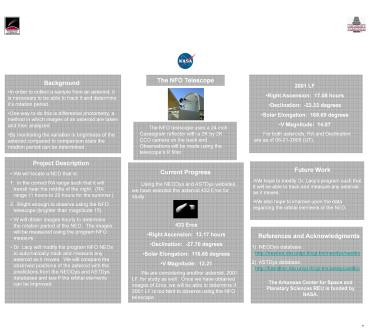Transiting Extrasolar Planets orbiting HD 209458 and TrES-1 - PowerPoint PPT Presentation
1 / 2
Title:
Transiting Extrasolar Planets orbiting HD 209458 and TrES-1
Description:
... websites, we have selected the asteroid 433 Eros for study. 433 Eros ... Once we have obtained images of Eros, we will be able to determine if 2001 LF is ... – PowerPoint PPT presentation
Number of Views:106
Avg rating:3.0/5.0
Title: Transiting Extrasolar Planets orbiting HD 209458 and TrES-1
1
Near Earth Objects
- Rozmin Daya1, 2, Claud Lacy1, 3
- 1. Arkansas Center for Space and Planetary
Sciences, University of Arkansas, Fayetteville,
AR 72701 - Physics Department, Southern Methodist
University, Dallas, TX 75275 - Physics Department, University of Arkansas,
Fayetteville, AR 72701
The NFO Telescope
Background
- 2001 LF
- Right Ascension 17.08 hours
- Declination -23.33 degrees
- Solar Elongation 168.69 degrees
- V Magnitude 14.87
- For both asteroids, RA and Declination are as of
06-21-2005 (UT).
- In order to collect a sample from an asteroid, it
is necessary to be able to track it and determine
its rotation period. - One way to do this is differential photometry, a
method in which images of an asteroid are taken
and then analyzed. - By monitoring the variation in brightness of the
asteroid compared to comparison stars the
rotation period can be determined.
The NFO telescope uses a 24 inch Cassegrain
reflector with a 2K by 2K CCD camera on the back
end. Observations will be made using the
telescopes R filter.
Project Description
Future Work
Current Progress
- We will locate a NEO that is
- in the correct RA range such that it will
transit near the middle of the night. (RA range
11 hours to 23 hours for the summer.) - Bright enough to observe using the NFO
telescope (brighter than magnitude 15). - W will obtain images hourly to determine the
rotation period of the NEO. The images will be
measured using the program NFO measure. - Dr. Lacy will modify his program NFO NEOs to
automatically track and measure any asteroid as
it moves. We will compare the observed positions
of the asteroid with the predictions from the
NEODys and ASTDys databases and see if the
orbital elements can be improved.
- We hope to modify Dr. Lacys program such that it
will be able to track and measure any asteroid as
it moves. - We also hope to improve upon the data regarding
the orbital elements of the NEO.
- Using the NEODys and ASTDys websites, we have
selected the asteroid 433 Eros for study. - 433 Eros
- Right Ascension 13.17 hours
- Declination -27.70 degrees
- Solar Elongation 116.65 degrees
- V Magnitude 12.21
- We are considering another asteroid, 2001 LF,
for study as well. Once we have obtained images
of Eros, we will be able to determine if 2001 LF
is too faint to observe using the NFO telescope.
References and Acknowledgments
- NEODys database. http//newton.dm.unipi.it/cgi-b
in/neodys/neoibo - ASTDys database. http//hamilton.dm.unipi.it/cgi
-bin/astdys/astibo
The Arkansas Center for Space and Planetary
Sciences REU is funded by NASA.
2
Transiting Extrasolar Planets Orbiting HD 209458
and TrES-1
- Rozmin Daya1, 2, Claud Lacy1, 3
- 1. Arkansas Center for Space and Planetary
Sciences, University of Arkansas, Fayetteville,
AR 72701 - Physics Department, Southern Methodist
University, Dallas, TX 75275 - Physics Department, University of Arkansas,
Fayetteville, AR 72701
The NFO Telescope
Background
average intensity over the second and fifth
(out-of-transit) orbits.2 (Images were obtained
using the Hubble Space Telescope.)
- Extrasolar planets can be detected when they
transit their parent star blocking a percentage
of its light. - This can give information about the planets
orbital period, radius, mass, density, and
distance from its parent star.
The NFO telescope uses a 24 inch Cassegrain
reflector with a 2K by 2K CCD camera on the back
end. For HD 209458, observations are being made
using B, V, and R filters for TrES-1,
observations are being made using the R filter.
Project Description
- Transits of the planets HD 209458b and TrES-1b
will be photographed using the NFO telescope in
Silver City, New Mexico. - These images will be measured using the program
Measure. - Light curves for the stars will be constructed.
- The light curves will be analyzed using the
program EBOP, which uses the Nelson-Davis-Etzel
model code. - Orbital data for the planets will be obtained
from these curves. We will try to improve on the
orbital data from previous observations.
Current Progress
Data and Graphs
Currently we are using the telescope to obtain
images of the transits. As we get the images, we
measure them. Once all data is collected we will
continue with the remaining steps of the project.
Below and to the left are the light curves for
TrES-1. The curves were constructed using images
from various telescopes in the Trans-Atlantic
Exoplanet Survey (TrES) network. Below and to
the right is the orbital data for TrES-1b.1
References and Acknowledgments
- Alonso et al., Astrophysical Journal Letters,
613, L153 - Brown, T. M., Charbonneau, D., Gilliland, R.
L., Noyes, R. W., Burrows, A. 2001,
Astrophysical Journal, 552, 699
Schematic illustration of the light curve of a
transiting planet. Measurable quantities
duration of the transit l, the transit depth d,
the ingress/egress duration w, and the central
curvature of the light curve C. 2
The Arkansas Center for Space and Planetary
Sciences REU is funded by NASA.
Below is the light curve for HD209458. This is
the phased light curve for all four transits,
assuming a planetary orbital period of 3.52474
days. The time series for each transit has been
scaled to have the same































